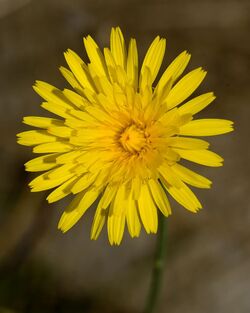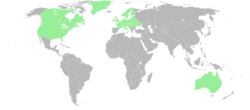Biology:Hieracium lachenalii
| Hieracium lachenalii | |
|---|---|

| |
| Scientific classification | |
| Kingdom: | Plantae |
| Clade: | Tracheophytes |
| Clade: | Angiosperms |
| Clade: | Eudicots |
| Clade: | Asterids |
| Order: | Asterales |
| Family: | Asteraceae |
| Genus: | Hieracium |
| Species: | H. lachenalii
|
| Binomial name | |
| Hieracium lachenalii Suter 1802 not C.C.Gmel. 1808[1]
| |

| |
| Hieracium lachenalii distribution | |
| Synonyms[2] | |
|
Synonymy
| |
Hieracium lachenalii, also known as common hawkweed or yellow hawkweed, is a species of plant in the tribe Cichorieae within the family Asteraceae. It is native to Europe but has become established as a weed in Australia and parts of North America. The species was widely known for many years as H. vulgatum,[3] but more recent studies have indicated that the two names represent the same species. The name H. lachenalii was coined in 1802,[4] H. vulgatum in 1819,[5] so the older name is to be used.[6]
Description
This common weed can grow and produce flowers on plants that range from 4 inches (10 centimeters) to 36 inches (91 cm) tall. The rhizome is short and stout. The broadly elliptic leaves can be up to 5 inches (13 centimeters) long and taper with teeth towards the base.[7] Each flower head has 40-80 ray florets but no disc florets[8][9] Bracts surround the flower head; the receptacle (basal part of the flower on which the florets are attached) is flat and naked; heads tend to start together then become somewhat solitary on long leafless stems.[8] The stalks below the heads are covered with scattered, simple and gland-tipped black hairs and contain a milky substance.[9]
The pale yellow flowers are produced during all of the summer months. The fruit are dark brown achenes.[7]
Common names
- Croatian: Obična runjika
- Dutch: Gewoon havikskruid
- German: Gewöhnliches Habichtskraut, Lachenals Habichtskraut
- English: Common Hawkweed, Yellow Hawkweed
- French: Epervière de Lachenal
- Hungarian: Közönséges hölgymál[10]
- Italian: Sparviere comune
- Latvian: Jakarda mauraga
- Polish: Jastrzębiec Lachenala
- Serbian: Maslačak
- Slovene: Lachenalova škržolica, Navadna škržolica
- Russian: Ястребинка Жаккара[11]
- Welsh: Heboglys
- Swedish: Hagfibbla
Distribution and habitat
Native to most of Europe,[11] Hieracium lachenalii was introduced to cooler parts of North America,[12] and to Australia.[8] It can sometimes be found in soils that have been disturbed.[13]
Europe
Austria, Belarus , Belgium, Bosnia-Herzegovina, Channel Islands, Republic of Croatia, Corsica, Czech Republic, Denmark , Estonia, France , Finland , Germany , Republic of Hungary, Ireland, Italy, Latvia, Principality of Liechtenstein, Lithuania, Grand Duchy of Luxemburg, Montenegro, Netherlands, North Macedonia, Republic of North Ossetia–Alania, Norway , Poland , Romania, San Marino, Serbia, Slovenia, Slovakia, Sweden, Switzerland , Ukraine , United Kingdom , Vatican City, and various oblasts of Russia :
and its autonomous republics:
North America
Subarctic America: Greenland.[14]
Canada: British Columbia, New Brunswick, Newfoundland, Nova Scotia, Ontario, Prince Edward Island, Quebec.[14]
United States: Connecticut, Delaware, Maine, Massachusetts , Michigan, Minnesota, New Hampshire, New Jersey, New York, Oregon, Pennsylvania, Rhode Island, Vermont, Washington, Wisconsin.[14]
References
- ↑ Tropicos, search for Hieracium lachenalii
- ↑ The Plant List, Hieracium lachenalii Suter
- ↑ Flora of North America, Hieracium vulgatum Fries, 1819.
- ↑ The International Plant Names Index, Hieracium lachenalii
- ↑ The International Plant Names Index, Hieracium vulgatum
- ↑ International Code of Nomenclature for algae, fungi, and plants (Melbourne Code), article 11
- ↑ 7.0 7.1 MSU Board of Trustees; Jesse L Saylor. "MSUplants.com Hieracium lachenalii". msuplants.com/index.html. Michigan State University Department of Horticulture. http://msuplants.com/pd.asp?pid=3104.
- ↑ 8.0 8.1 8.2 Ian Faithfull (2007-09-19). "Hawkweeds: State Prohibited Weed". Information Notes Series. Department of Primary Industries, Victoria, Australia. http://www.dpi.vic.gov.au/DPI/nreninf.nsf/childdocs/-9B2A7AB4FD562D03CA256BC800058E91-FAE39D5678422E99CA256BC800062A59-663C5274163D2336CA256E8D001EFC6C-A348BEAAE2BC7393CA256D4A000C59A3?open.
- ↑ 9.0 9.1 Mrs. M. Grieve (1933). "Hawkweed, Wood". A Modern Herbal. Botanical.com. http://www.botanical.com/botanical/mgmh/h/hawwee07.html.
- ↑ Az ANP (valamint a Gömör-Tornai-karszt magyarországi részének) taxonlistája
- ↑ 11.0 11.1 11.2 "Details for: Hieracium lachenalii". The Euro+Med Plantbase. Botanic Garden and Botanical Museum Berlin-Dahlem. June 5, 2007. http://ww2.bgbm.org/EuroPlusMed/PTaxonDetail.asp?NameCache&61%3BHieracium&32%3Blachenalii&PTRefFk&61%3B7000000.[yes|permanent dead link|dead link}}]
- ↑ Biota of North America Program 2014 state-level distribution map
- ↑ Paul Slichter. "Common Hawkweed". Wildflowers of the Genus Hieracium:Hawkweeds of the Columbia River Gorge. http://ghs.gresham.k12.or.us/science/ps/nature/gorge/sun/dandy/hieracium/hieracvulgatum.htm. "Common hawkweed may be found in disturbed soils."
- ↑ 14.0 14.1 14.2 {{citation | mode = cs1 | title = Hieracium lachenalii | work = Germplasm Resources Information Network (GRIN) | url = | publisher = [[Organization:Agricultural Research ServAgricultural Research Service (ARS), United States Department of Agriculture (USDA) | access-date = 2007-12-14 }}
External links
- Integrated Taxonomic Information System Organization (ITIS) (December 14, 2007). "Hieracium lachenalii". Integrated Taxonomic Information System on-line database. https://www.itis.gov/servlet/SingleRpt/SingleRpt?search_topic=TSN&search_value=503024.
- Paul Slichter. "Common Hawkweed". Wildflowers of the Genus Hieracium:Hawkweeds of the Columbia River Gorge. http://ghs.gresham.k12.or.us/science/ps/nature/gorge/sun/dandy/hieracium/hieracvulgatum.htm.
- Stonehill College. "Common Hawkweed (Hieracium vulgatum)". Stonehill College Field Guide. http://education.stonehill.edu/fieldguide/Field_Guide/Small%20flowering/Hawkweed.htm.
Wikidata ☰ Q1521028 entry
 |



